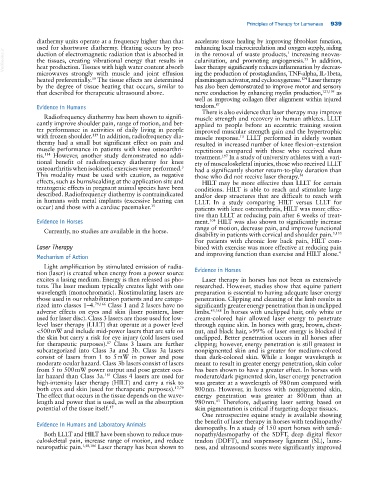Page 973 - Adams and Stashak's Lameness in Horses, 7th Edition
P. 973
Principles of Therapy for Lameness 939
diathermy units operate at a frequency higher than that accelerate tissue healing by improving fibroblast function,
used for shortwave diathermy. Heating occurs by pro- enhancing local microcirculation and oxygen supply, aiding
VetBooks.ir the tissues, creating vibrational energy that results in cularization, and promoting angiogenesis. In addition,
in the removal of waste products, increasing neovas-
duction of electromagnetic radiation that is absorbed in
1
33
heat production. Tissues with high water content absorb
laser therapy significantly reduces inflammation by decreas-
microwaves strongly with muscle and joint effusion ing the production of prostaglandins, TNF‐alpha, IL‐1beta,
heated preferentially. The tissue effects are determined plasminogen activator, and cyclooxygenase. Laser therapy
124
59
by the degree of tissue heating that occurs, similar to has also been demonstrated to improve motor and sensory
that described for therapeutic ultrasound above. nerve conduction by enhancing myelin production, 123,195 as
well as improving collagen fiber alignment within injured
Evidence in Humans tendons. 87
There is also evidence that laser therapy may improve
Radiofrequency diathermy has been shown to signifi- muscle strength and recovery in human athletes. LLLT
cantly improve shoulder pain, range of motion, and bet- applied to people before an eccentric training session
ter performance in activities of daily living in people improved muscular strength gain and the hypertrophic
with frozen shoulder. In addition, radiofrequency dia- muscle response. LLLT performed in elderly women
119
13
thermy had a small but significant effect on pain and resulted in increased number of knee flexion–extension
muscle performance in patients with knee osteoarthri- repetitions compared with those who received sham
tis. However, another study demonstrated no addi- treatment. In a study of university athletes with a vari-
114
197
tional benefit of radiofrequency diathermy for knee ety of musculoskeletal injuries, those who received LLLT
osteoarthritis when isokinetic exercises were performed. had a significantly shorter return‐to‐play duration than
3
This modality must be used with caution, as negative those who did not receive laser therapy. 54
effects, such as burns/scalding at the application site and HILT may be more effective than LLLT for certain
teratogenic effects in pregnant animal species have been conditions. HILT is able to reach and stimulate large
described. Radiofrequency diathermy is contraindicated and/or deep structures that are difficult to reach with
in humans with metal implants (excessive heating can LLLT. In a study comparing HILT versus LLLT for
occur) and those with a cardiac pacemaker. 35 patients with knee osteoarthritis, HILT was more effec-
tive than LLLT at reducing pain after 6 weeks of treat-
Evidence in Horses ment. HILT was also shown to significantly increase
104
range of motion, decrease pain, and improve functional
Currently, no studies are available in the horse.
disability in patients with cervical and shoulder pain. 5,153
For patients with chronic low back pain, HILT com-
Laser Therapy bined with exercise was more effective at reducing pain
and improving function than exercise and HILT alone. 4
Mechanism of Action
Light amplification by stimulated emission of radia-
tion (laser) is created when energy from a power source Evidence in Horses
excites a lasing medium. Energy is then released as pho- Laser therapy in horses has not been as extensively
tons. The laser medium typically creates light with one researched. However, studies show that equine patient
wavelength (monochromatic). Biostimulating lasers are preparation is essential to having adequate laser energy
those used in our rehabilitation patients and are catego- penetration. Clipping and cleaning of the limb results in
rized into classes 1–4. 79,166 Class 1 and 2 lasers have no significantly greater energy penetration than in unclipped
adverse effects on eyes and skin (laser pointers, laser limbs. 43,168 In horses with unclipped hair, only white or
used for laser disc). Class 3 lasers are those used for low‐ cream‐colored hair allowed laser energy to penetrate
level laser therapy (LLLT) that operate at a power level through equine skin. In horses with gray, brown, chest-
<500 mW and include mid‐power lasers that are safe on nut, and black hair, >99% of laser energy is blocked if
the skin but carry a risk for eye injury (cold lasers used unclipped. Better penetration occurs in all horses after
for therapeutic purposes). Class 3 lasers are further clipping; however, energy penetration is still greatest in
17
subcategorized into Class 3a and 3b. Class 3a lasers nonpigmented skin and is greater for medium‐colored
consist of lasers from 1 to 5 mW in power and pose than dark‐colored skin. While a longer wavelength is
moderate ocular hazard. Class 3b lasers consist of lasers meant to result in greater energy penetration, skin color
from 5 to 500 mW power output and pose greater ocu- has been shown to have a greater effect. In horses with
lar hazard than Class 3a. Class 4 lasers are used for moderate/dark pigmented skin, laser energy penetration
181
high‐intensity laser therapy (HILT) and carry a risk to was greater at a wavelength of 980 nm compared with
both eyes and skin (used for therapeutic purposes). 17,79 800 nm. However, in horses with nonpigmented skin,
The effect that occurs in the tissue depends on the wave- energy penetration was greater at 800 nm than at
length and power that is used, as well as the absorption 980 nm. Therefore, adjusting laser setting based on
43
potential of the tissue itself. 17 skin pigmentation is critical if targeting deeper tissues.
One retrospective equine study is available showing
the benefit of laser therapy in horses with tendinopathy/
Evidence in Humans and Laboratory Animals
desmopathy. In a study of 150 sport horses with tendi-
Both LLLT and HILT have been shown to reduce mus- nopathy/desmopathy of the SDFT, deep digital flexor
culoskeletal pain, increase range of motion, and reduce tendon (DDFT), and suspensory ligament (SL), lame-
neuropathic pain. 1,48,186 Laser therapy has been shown to ness, and ultrasound scores were significantly improved

